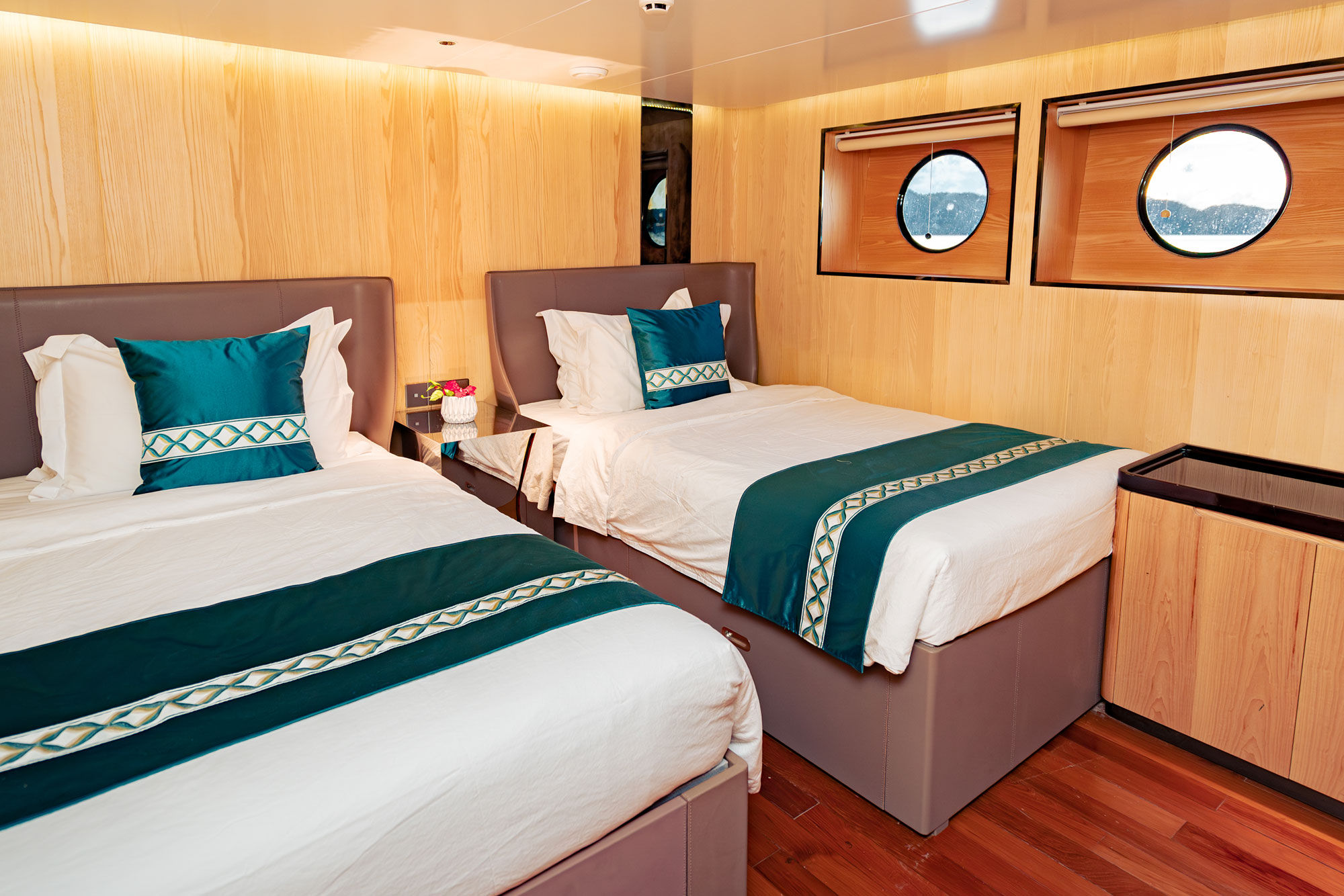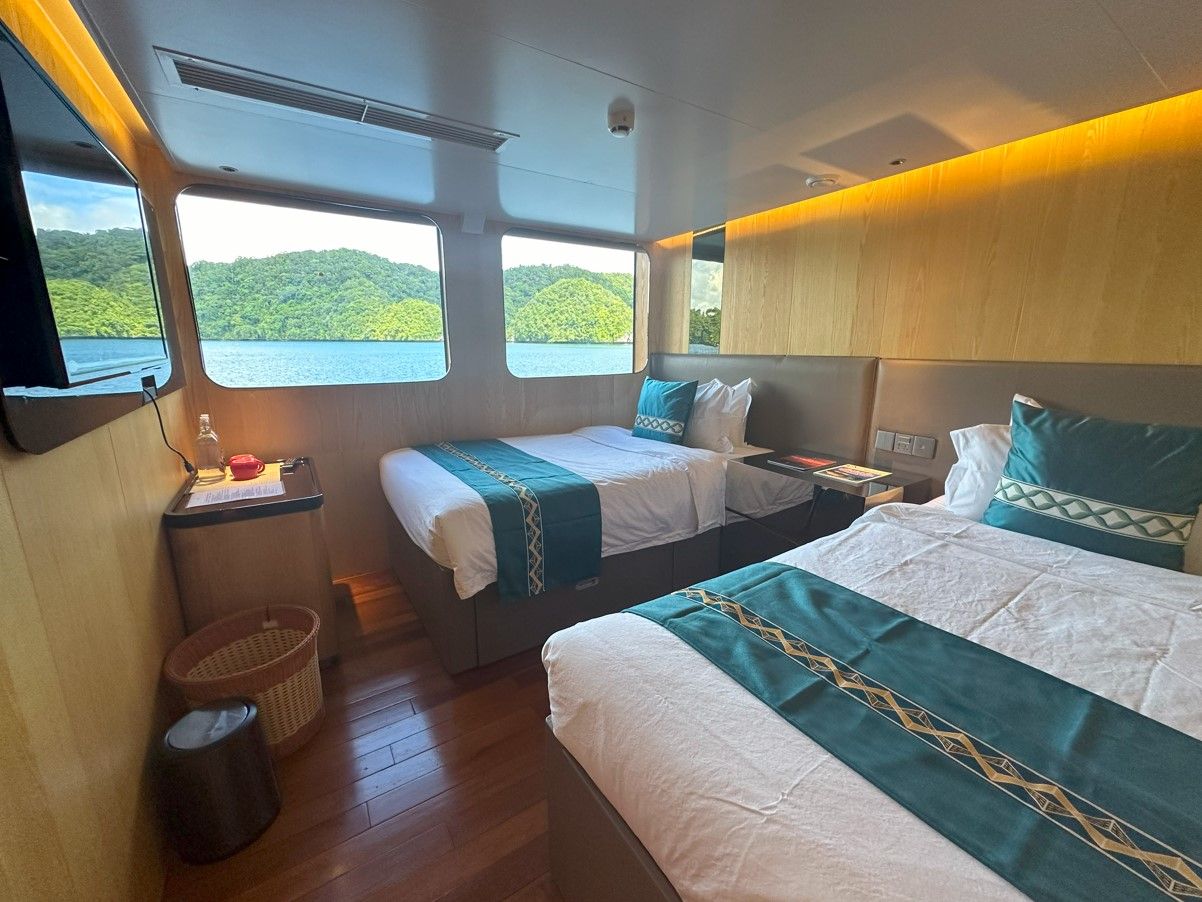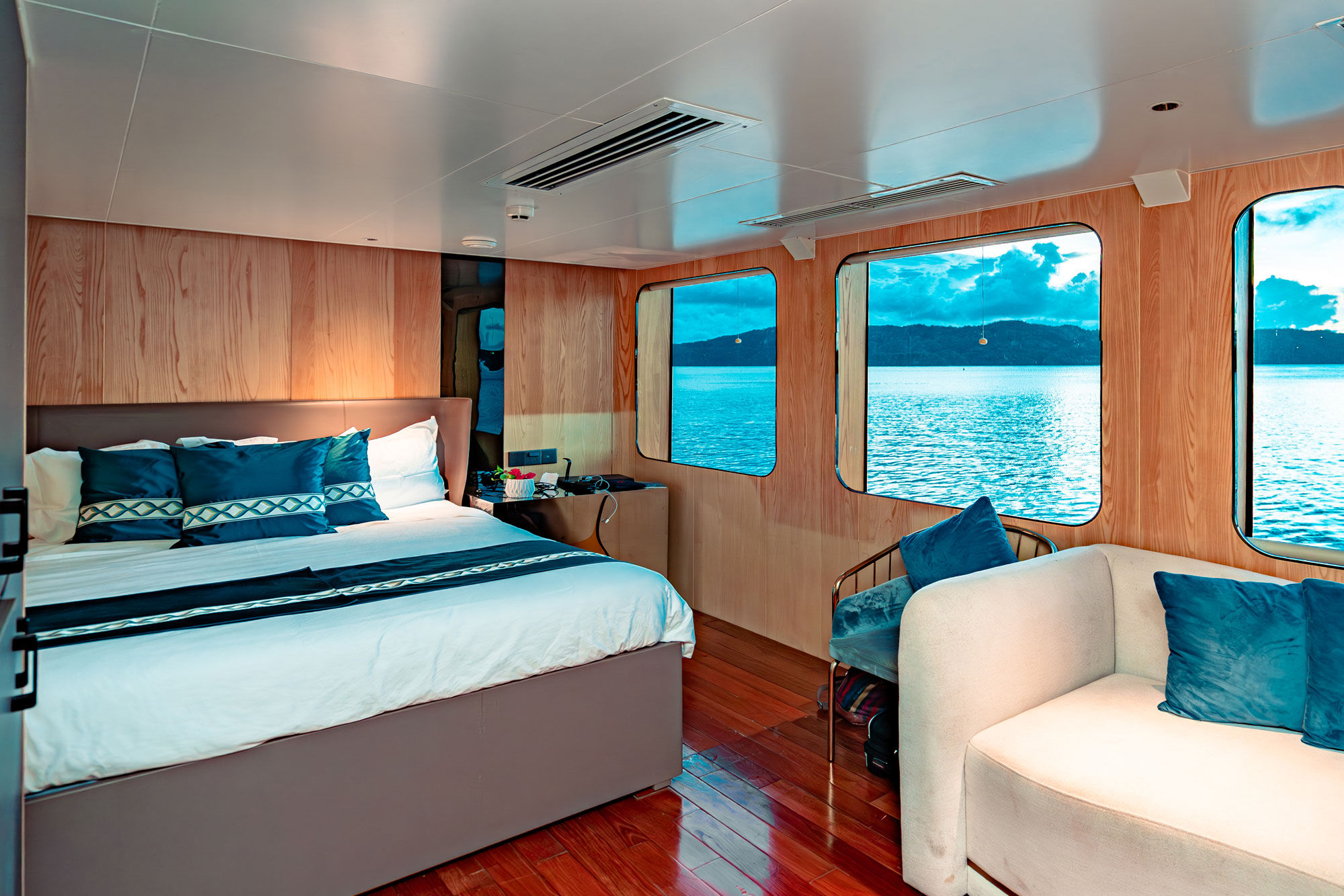日程安排
帕劳(Palau)拥有世界上最好的潜水地点,7晚潜水船宿之旅是体验所有这些潜水点的完美方式。一个不可错过的景点是蓝角(Blue Corner),强烈的海流吸引大量海洋生物,包括鲨鱼、梭鱼和鱼群。另一个受欢迎的地点是德国水道(German Channel),这里常常能看到蝠鲼。Ulong Channel也是一大亮点,它在两岛间形成狭窄的通道,拥有令人难以置信的珊瑚和多样的海洋生物。吊灯洞(Chandelier Cave)有着独特的地下室和空气袋,不容错过。对于寻求独特体验的人来说,水母湖(Jellyfish Lake)中居住着无数无害水母,可以与之游泳。帕劳确实适合每个人,潜水船宿之旅是探索所有令人叹为观止的潜水点的绝佳方式。
以下是您在Black Pearl潜水船宿航程中的样本行程。潜水团队希望向您展示最好的潜水,但多种因素决定了船只航行的路线和潜水地点选择。
潜水团队将安排每天最多4次潜水;3次白天潜水和一次日落或夜潜。一个常规潜水日安排如下:
常规潜水日安排
- 晨间咖啡&茶搭配轻食,随后简报。潜水1
- 早餐,水面休息,随后简报。潜水2
- 午餐,水面休息,随后简报。潜水3
- 点心&饮料时间
- 日落或夜潜简报
- 晚餐
ROCK ISLANDS & JELLYFISH LAKE TOUR
在巡航途中,我们的行程包括参观两个重要的旅游景点:石岛(Rock Islands)和世界闻名的水母湖(Jellyfish Lake),该湖最近重新向公众开放!
BLUE CORNER
帕劳最著名的潜水地点是蓝角(Blue Corner),这个角是一个平的高原,向海中延伸几百码后陡然下降,墙壁垂直而深,以其丰富的海洋生命闻名。
这里有大量的大型远洋鱼类,您不仅可以期待遇见大量杰克鱼、大眼/蓝鳍鲹、黑鳍梭鱼和红鲷鱼,还能看到鲨鱼、金枪鱼、金枪鱼、石斑鱼、鹰鳐、隆头鹦哥鱼、绿海龟和玳瑁龟——所有这些都在一次潜水中!
还有叶形蝎子鱼、海蛞蝓、海鳗、狮子鱼、拳击蟹、海葵鱼、硬珊瑚、软珊瑚和巨型海扇。如果幸运,您甚至可能看到蝠鲼或旗鱼,甚至可能看到鲸鲨!蓝角的深处偶尔可以看到更大的远洋鱼类:锤头鲨、公牛鲨、虎鲨、马林鱼和鲸类。
像其他许多主要潜水点一样,蓝角的特殊之处在于它滋养生命链的强大潮流。此潜水地点适合高级潜水员。
BLUE HOLES
蓝洞(Blue Holes)是位于Ngemelis Island北侧的一个巨大洞穴,靠近蓝角(Blue Corner)。它有多个入口,从浅礁顶及墙壁的较深处均可进入。在内部,阳光从上方照射进来,令人难忘的美景让人难以忘怀。洞顶上有四个大洞(约5×3米),使大量自然光线进入洞穴,创造出绝佳摄影机会,您可以朝洞口游去,拍摄一些优美的剪影。
在20至25米深度体验蓝洞,宽敞的主洞适合所有经验层次的潜水员,但26米深处有一个狭窄洞穴,仅可由装备齐全并认证的洞穴潜水员探索。
礁本身是围绕两处景点的另一吸引之处,岩礁上分布有巨石和皱叶珊瑚。掉落在墙壁上,您会找到健康的硬珊瑚和软珊瑚的混合物,以及海绵和巨型海扇。
在蓝洞内可以发现的特殊小生物有火焰扇贝、叶形蝎子鱼、小丑鱼、海蛞蝓和清洁虾。
CHANDELIER CAVE
吊灯洞(Chandelier Cave)曾是一个露天洞穴潜水地点,现在是一个拥有多个房间的大洞。您可以在8米处进入洞穴,并在几个不同的房间内浮出水面。水下通道可让您在房间之间游动,房间中有空气袋,4个房间充满水。
这是一个非常酷的地方,经过千年,雨水慢慢渗入石灰石中,侵蚀岛屿的内部,形成庞大的洞穴系统。这里是拍摄潜水员广角照片的好去处,结晶形态从天花板上悬挂下来,具有最优雅和美丽的景观。
这是一个非常冒险的潜水,需记住这是一个头顶环境——某些地方您看不到任何光线,能见度可能降至零,潜水员必须配备潜水手电筒,幽闭恐惧症者以及对黑暗潜水感到不安者应避免此潜水。
GERMAN CHANNEL
德国水道(German Channel)以其珊瑚礁蝠鲼、鹰鳐、花园鳗、红鲷鱼、梭鱼、蓝鳍金枪鱼、礁鲨和多种鱼类群而闻名。这个狭窄的通道将Ngemelis Island和Ngercheu Islands分开,形成内泻湖和外海之间的连接。
德国水道是一个人工浅水道,连接珊瑚礁外海。德国人于20世纪早期炸开此道,以便从Angaur Island将磷矿运输到Kioor港。
今天,许多蝠鲼访问水道并以强大潮流带来的浮游生物为食。水道口的少量清洗站允您以极短距离观察这些伟大生物。清洗站在18米,美丽的珊瑚花园在7-13米。
然而,当浮出水面时要非常小心,因为这里的船流量可能非常大。在最终上升前,请确保放出安全标志浮球(SMB)。
THE NGEMELIS WALL
Ngemelis Wall被认为是世界上最好的墙潜之一。从仅及膝深的水开始,墙壁垂直落下,几乎达到300米。在停泊浮标附近,可以看到一条与一个2米钢球相连的大链条,这条链和球在二战期间被用于阻止日本人进入通向德国水道的水道。
潜水员可以自由浮潜,穿过华丽的彩虹海绵和软珊瑚,它们的蓝色、红色或纯白色形成了背景,三米高的巨大海扇与巨大的橙黄色和巨大的黑珊瑚树形成背景。鱼群齐聚于此:金字塔蝶鱼、军曹鱼、黄尾鲶鱼、帝王鱼、天使鱼、叶鱼、石鱼、狮子鱼、绿海龟和玳瑁龟。礁鲨、护士鲨和豹鲨可以在沙质底部见到。
ULONG CHANNEL (NGERUMEKAOL PASS)
Ulong Channel被许多潜水员认为是世界最佳漂流潜之一,位于Ulong Island西侧,潮水进入时通常能看到鲨鱼,是帕劳最好的肾上腺素潜点之一。以其强大的海流、季节性产卵活动和鲨鱼游弋而闻名,是一条宽50米的狭窄通道,将巨大的高原一分为二。最清澈,潮水进入时能见度高达30米。
您可以欣赏美丽的珊瑚、拿破仑龙虾、黄貂鱼、红鲷、杰克、石斑鱼的大群蝴蝶鱼和黄尾银鲳,以及海龟。在通道入囗处,于礁鲨和梭鱼滑过的动作时停留。
解开和进入通道的海流,漂流穿过平均10米深的沙底,上有珊瑚形成,鱼类丰富,可能还有在狭窄通道巡游的鲨鱼。最如画的一景是环绕着松鼠鱼和士兵鱼的巨型莴苣珊瑚花园。
在四月到七月间,通道也是成千红石斑鱼在满月期间的产卵地点。请注意巨型触发鱼,因为它们可能非常具有攻击性,尤其当您靠近其巢穴时。
HELMET WRECK
Helmet Wreck是战时物资和船舶文物的宝藏。这艘日本轮被沉没在二战时期,是在帕劳一定要体验的沉船潜点。船尾停泊在约15米,而船头则在33米。因为在后货舱内可以看到堆叠的头盔,他们在数十年的水下腐蚀后已凝结在一起而得名。其他显著特征包括步枪、弹药箱、桶、锅、瓶子、电子零件、旧日本清酒瓶、深水炸弹和几个防毒面具。
货舱很容易进入,因为它们全部敞开,在船头的货舱内,您可以看到Zeke战机的发动机和电子设备。
记住不要碰任何东西,因为周围仍有杀伤弹药和深水炸弹。
SIAES CORNER/TUNNEL
Siaes Corner是帕劳著名的墙壁之一,在约20米处潜水员遭遇隧道入口处之一。至少约4 x 6米宽,入口通向一个大洞穴。外侧墙壁垂直降至约45米,然后在海床处斜着下降数百米。
可期望在隧道内外见到大量鲨鱼、杰克鱼、红鲷、蓝鳍金枪鱼、海龟和黄貂鱼。
隧道内,多彩的软硬珊瑚点缀着墙壁。在沙地底部休息的黄貂鱼和白鳍礁鲨很常见。炫彩天使鱼(蓝黑侏儒天使、科林天使鱼),以及行为和虾米通常栖于隧道内的沙质洞底。
建议潜水员带上水下手电筒以更好地探索隧道。
PELELIU WALL
Peleliu Express位于Peleliu Island的南端,在这开放海洋电流在群岛之南端汇合。
强劲的交汇电流吸引大生物,包括礁鲨、巨石斑鱼、拿破仑隆头鱼、梭鱼、金枪鱼、外科鱼、彩虹跑鱼、西班牙鲭鱼和鹰鳐。如果您幸运的话,已知在此潜点见到过领航鲸、抹香鲸、鲸鲨、锤头鲨、逆戟鲸和旗鱼的稀有访问。
Peleliu Express在潜水界内取得狂热地位,并提供在太平洋的一些最佳漂流潜水。高台墙壁上覆盖着美丽的珊瑚,有软硬品种,并在帕劳常见的热带鱼学校中效起人群。
电流变化没有提前警告,经验丰富的潜水员可以经常体验超过4节的电流。此点仅适合有经验的潜水员。
PELELIU EXPRESS
《帕劳诗集》位于岛屿最南端的壮观墙壁潜点,此潜点位于以其极快漂流潜水而闻名的部分礁上,具有帕劳一些最强的电流。它是Peleliu Wall的一部分,这是帕劳已知最深的礁。为潜水员提供了在墙沿快速运动的体验,以保证看到许多不同的珊瑚和大量的海洋生物。
潜水员能看到沿墙巨大的海扇和其他软珊瑚、海葵、海鞭和许多硬珊瑚。潜水员会被梭鱼、杰克、鹰鳐、海龟、红鲷、隆头鹦哥鱼、拿破仑隆头鱼和随电流漂流的礁鲨所包围。
潜水员也可能看到公牛鲨、虎鲨、锤头鲨和鲸类。潜水员可以在墙的一些部分停下来探索许多由于潮水持续动作而雕刻的悬崖、缝隙、洞穴,此类地方容纳着大量隐藏的海洋生物。
由于强电流,此点仅适合高级潜水员。
最后一次潜水将在行程倒数第二天进行。建议潜水员在最后一次潜水后等待24小时再进行飞行。
样本行程和地图仅供说明之用。具体的路线和游览的站点可能会基于当地法规、客人经验、天气和后勤而发生变化,这些均由船长决定。
 微信扫码添加人工客服
微信扫码添加人工客服



